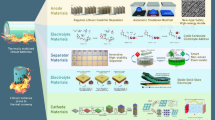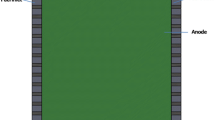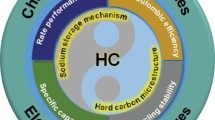Abstract
Mechanical degradation, especially fractures in active particles in an electrode, is a major reason why the capacity of lithium-ion batteries fades. This paper proposes a model that couples Li-ion diffusion, stress evolution, and damage mechanics to simulate the growth of central cracks in cathode particles \((\hbox {LiMn}_{2}\hbox {O}_{4})\) by an extended finite element method by considering the influence of multiple factors. The simulation shows that particles are likely to crack at a high discharge rate, when the particle radius is large, or when the initial central crack is longer. It also shows that the maximum principal tensile stress decreases and cracking becomes more difficult when the influence of crack surface diffusion is considered. The fracturing process occurs according to the following stages: no crack growth, stable crack growth, and unstable crack growth. Changing the charge/discharge strategy before unstable crack growth sets in is beneficial to prevent further capacity fading during electrochemical cycling.







Similar content being viewed by others
References
Palacín, M.R., de Guibert, A.: Why do batteries fail? Science 351, 1253292 (2016)
Chiang, Y.M.: Building a better battery. Nature 330, 1485–1486 (2010)
Ebner, M., Marone, F., Stampanoni, M., et al.: Visualization and quantification of electrochemical and mechanical degradation in Li-ion batteries. Science 342, 716–720 (2013)
Nitta, N., Wu, F., Lee, J.T., et al.: Li-ion battery materials: present and future. Mater. Today 18, 252–264 (2015)
Goodenough, J.B., Kim, Y.: Challenges for rechargeable Li batteries. Chem. Mater. 22, 587–603 (2010)
Xu, R., Zhao, K.: Electrochemomechanics of electrodes in Li-ion batteries: a review. J. Electrochem. Energy 13, 030803 (2016)
Kabir, M.M., Demirocak, D.E.: Degradation mechanisms in Li-ion batteries: a state-of-the-art review. Int. J. Energy Res. 41, 1963–1986 (2017)
Li, Y., Li, Y., Pei, A., et al.: Atomic structure of sensitive battery materials and interfaces revealed by cryo-electron microscopy. Science 358, 506–510 (2017)
Guo, Z.S., Zhu, J., Feng, J., et al.: Direct in situ observation and explanation of lithium dendrite of commercial graphite electrodes. RSC Adv. 5, 69514–69521 (2015)
Mukhopadhyay, A., Sheldon, B.W.: Deformation and stress in electrode materials for Li-ion batteries. Prog. Mater. Sci. 63, 58–116 (2014)
Lin, X., Lu, W.: A battery model that enables consideration of realistic anisotropic environment surrounding an active material particle and its application. J. Power Sources 357, 220–229 (2017)
Arora, P., White, R.E., Doyle, M.: Capacity fade mechanisms and side reactions in lithium-ion batteries. J. Electrochem. Soc. 145, 3647–3667 (1998)
Deshpande, R., Verbrugge, M., Cheng, Y.T., et al.: Battery cycle life prediction with coupled chemical degradation and fatigue mechanics. J. Electrochem. Soc. 159, A1730–A1738 (2012)
Lee, S.W., Lee, H.W., Ryu, I., et al.: Kinetics and fracture resistance of lithiated silicon nanostructure pairs controlled by their mechanical interaction. Nat. Commun. 6, 7533 (2015)
Christensen, J., Newman, J.: A mathematical model of stress generation and fracture in lithium manganese oxide. J. Electrochem. Soc. 153, A1019–A1030 (2005)
Christensen, J., Newman, J.: Stress generation and fracture in lithium insertion materials. J. Solid State Electrochem. 10, 293–319 (2006)
Zhang, X., Shyy, W., Sastry, A.M.: Numerical simulation of intercalation-induced stress in Li-ion battery electrode particles. J. Electrochem. Soc. 154, A910–A916 (2007)
Cheng, Y.T., Verbrugge, M.W.: Evolution of stress within a spherical insertion electrode particle under potentiostatic and galvanostatic operation. J. Power Sources 190, 453–460 (2009)
Korsunsky, A.M., Sui, T., Song, B.: Explicit formulae for the internal stress in spherical particles of active material within lithium ion battery cathodes during charging and discharging. Mater. Des. 69, 247–252 (2015)
Zhang, X., Hao, F., Chen, H., et al.: Diffusion-induced stresses in transversely isotropic cylindrical electrodes of lithium-ion batteries. J. Electrochem. Soc. 161, A2243–A2249 (2014)
Lu, Y., Ni, Y.: Stress-mediated lithiation in nanoscale phase transformation electrodes. Acta Mech. Solida Sin. 30, 248–253 (2017)
Ji, L., Guo, Z.: Analytical modeling and simulation of porous electrodes: Li-ion distribution and diffusion-induced stress. Acta Mech. Sin. https://doi.org/10.1007/s10409-017-0704-5 (in press)
Zhu, M., Park, J., Sastry, A.M.: Fracture analysis of the cathode in Li-ion batteries: a simulation study. J. Electrochem. Soc. 159, A492–A498 (2012)
Grantab, R., Shenoy, V.B.: Pressure-gradient dependent diffusion and crack propagation in lithiated silicon nanowires. J. Electrochem. Soc. 159, A584–A591 (2012)
Klinsmann, M., Rosato, D., Kamlah, M., et al.: Modeling crack growth during Li insertion in storage particles using a fracture phase field approach. J. Mech. Phys. Solids 92, 313–344 (2016)
Klinsmann, M., Rosato, D., Kamlah, M., et al.: Modeling crack growth during Li extraction and insertion within the second half cycle. J. Power Sources 331, 32–42 (2016)
Zhao, K., Pharr, M., Vlassak, J.J., et al.: Fracture of electrodes in lithium-ion batteries caused by fast charging. J. Appl. Phys. 108, 073517 (2010)
Woodford, W.H., Chiang, Y.M., Carter, W.C.: "Electrochemical shock" of intercalation electrodes: a fracture mechanics analysis. J. Electrochem. Soc. 157, A1052–A1059 (2010)
Woodford, W.H., Carter, W.C., Chiang, Y.M.: Design criteria for electrochemical shock resistant battery electrodes. Energy Environ. Sci. 5, 8014–8024 (2012)
Gao, Y.F., Zhou, M.: Coupled mechano-diffusional driving forces for fracture in electrode materials. J. Power Sources 230, 176–193 (2013)
Lei, H.J., Wang, H.L., Liu, B., et al.: Quantitative law of diffusion induced fracture. Acta. Mech. Sin. 32, 611–632 (2016)
Wang, H., Jang, Y.I., Huang, B., et al.: TEM study of electrochemical cycling-induced damage and disorder in \(\text{ LiCoO }_{2}\) cathodes for rechargeable lithium batteries. J. Electrochem. Soc. 146, 473–480 (1999)
Lim, M.R., Cho, W.I., Kim, K.B.: Preparation and characterization of gold-codeposited \(\text{ LiMn }_{2}\text{ O }_{4}\) electrodes. J. Power Sources 92, 168–176 (2001)
Ohzuku, T., Tomura, H., Sawai, K.: Monitoring of particle fracture by acoustic emission during charge and discharge of \(\text{ Li }/\text{ MnO }_{2}\) cells. J. Electrochem. Soc. 144, 3496–3500 (1997)
Gabrisch, H., Wilcox, J., Doeff, M.M.: TEM study of fracturing in spherical and plate-like \(\text{ LiFePO }_{4}\) particles. Electrochem. Solid State Lett. 11, A25–A29 (2008)
Wang, D., Wu, X., Wang, Z., et al.: Cracking causing cyclic instability of LiFePO\(_{4}\) cathode material. J. Power Sources 140, 125–128 (2005)
Liu, X.H., Zhong, L., Huang, S., et al.: Size-dependent fracture of silicon nanoparticles during lithiation. ACS Nano 6, 1522–1531 (2012)
Lin, N., Jia, Z., Wang, Z., et al.: Understanding the crack formation of graphite particles in cycled commercial lithium-ion batteries by focused ion beam-scanning electron microscopy. J. Power Sources 365, 235–239 (2017)
Zhang, H.L., Li, F., Liu, C., et al.: New insight into the solid electrolyte interphase with use of a focused ion beam. J. Phys. Chem. B 109, 22205–22211 (2005)
Takahashi, K., Srinivasan, V.: Examination of graphite particle cracking as a failure mode in lithium-ion batteries: a model-experimental study. J. Electrochem. Soc. 162, A635–A645 (2015)
Ebner, M., Geldmacher, F., Marone, F., et al.: X-ray tomography of porous, transition metal oxide based lithium ion battery electrodes. Adv. Energy Mater. 3, 845–850 (2013)
Bhattacharya, S., Riahi, A.R., Alpas, A.T.: A transmission electron microscopy study of crack formation and propagation in electrochemically cycled graphite electrode in lithium-ion cells. J. Power Sources 196, 8719–8727 (2011)
Choi, Y.S., Pharr, M., Kang, C.S., et al.: Microstructural evolution induced by micro-cracking during fast lithiation of single-crystalline silicon. J. Power Sources 265, 160–165 (2014)
Harris, S.J., Deshpande, R.D., Qi, Y., et al.: Mesopores inside electrode particles can change the Li-ion transport mechanism and diffusion-induced stress. J. Mater. Res. 25, 1433–1440 (2015)
Hu, Y., Zhao, X., Suo, Z.: Averting cracks caused by insertion reaction in lithium-ion batteries. J. Mater. Res. 25, 1007–1010 (2011)
He, X., Li, J., Cai, Y., et al.: Preparation of spherical spinel \(\text{ LiMn }_{2}{\text{ O }}_{4}\), cathode material for Li-ion batteries. Mater. Chem. Phys. 95, 105–108 (2006)
ABAQUS/Standard: Version 6.16. Hibbitt, Karlsson, Serensen, Inc. (2016)
Sun, G., Bhattacharya, S., Alpas, A.T.: Cyclic strain-induced crack growth in graphite during electrochemical testing in propylene carbonate-based Li-ion battery electrolytes. J. Mater. Sci. 53, 1297–1309 (2018)
Acknowledgements
Authors gratefully acknowledge the financial support of the National Natural Science Foundation of China (11472165 and 11332005).
Author information
Authors and Affiliations
Corresponding author
Rights and permissions
About this article
Cite this article
Zhang, Y., Guo, Z. Numerical computation of central crack growth in an active particle of electrodes influenced by multiple factors. Acta Mech. Sin. 34, 706–715 (2018). https://doi.org/10.1007/s10409-018-0764-1
Received:
Revised:
Accepted:
Published:
Issue Date:
DOI: https://doi.org/10.1007/s10409-018-0764-1




